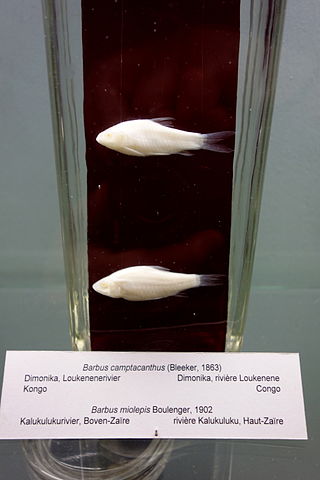
A tuna is a saltwater fish that belongs to the tribe Thunnini, a subgrouping of the Scombridae (mackerel) family. The Thunnini comprise 15 species across five genera, the sizes of which vary greatly, ranging from the bullet tuna up to the Atlantic bluefin tuna, which averages 2 m (6.6 ft) and is believed to live up to 50 years.

Mackerel is a common name applied to a number of different species of pelagic fish, mostly from the family Scombridae. They are found in both temperate and tropical seas, mostly living along the coast or offshore in the oceanic environment.

Herring are forage fish, mostly belonging to the family of Clupeidae.

Sardine and pilchard are common names for various species of small, oily forage fish in the herring family Clupeidae. The term sardine was first used in English during the early 15th century; a somewhat dubious folk etymology says it comes from the Italian island of Sardinia, around which sardines were once supposedly abundant.

The billfish are a group of saltwater predatory fish characterised by prominent pointed bills (rostra), and by their large size; some are longer than 4 m (13 ft). Extant billfish include sailfish and marlin, which make up the family Istiophoridae; and swordfish, sole member of the family Xiphiidae. They are often apex predators which feed on a wide variety of smaller fish, crustaceans and cephalopods. These two families are sometimes classified as belonging to the order Istiophoriformes, a group which originated around 71 million years ago in the Late Cretaceous, with the two families diverging around 15 million years ago in the Late Miocene. However, they are also classified as being closely related to the mackerels and tuna within the suborder Scombroidei of the order Perciformes. However, the 5th edition of the Fishes of the World does recognise the Istiophoriformes as a valid order, albeit including the Sphyraenidae, the barracudas.

The black goby is a species of ray-finned fish found in the Eastern Atlantic and Mediterranean Sea and Black Sea. It inhabits estuaries, lagoons, and inshore water over seagrass and algae. It feeds on a variety of invertebrates and sometimes small fish. This species can also be found in the aquarium trade.
Egirdira is a monospecific genus of ray-finned fish belonging to the subfamily Leuciscinae, its only species is Egirdira nigra, or the yag baligi, is a species of freshwater fish in the family Cyprinidae. It is found only in Turkey, in tributaries of Lake Egridir in Central Anatolia. It is considered an Endangered (EN) since 2013, an improvement from Critically Endangered (CR) which was the status between 1996 and 2006.
Neolamprologus niger is a species of cichlid endemic to Lake Tanganyika where it is only found along the northern shores. It is a crevice-dweller and feeds on molluscs. This species reaches a length of 9 centimetres (3.5 in) TL. It can also be found in the aquarium trade.
Chiloglanis niger is a species of upside-down catfish endemic to Cameroon, where it occurs in the Niger River basin at Bamenda. This species grows to a length of 3.5 centimetres (1.4 in) SL.
Mochokus niloticus is a species of upside-down catfish native to the Nile and Niger River basins. This species grows to a length of 6.5 centimetres (2.6 in) TL.
Synodontis gobroni is a species of upside-down catfish native to the Niger River basin where it is found in the nations of Guinea, Mali, Niger and Nigeria. This species grows to a length of 60 centimetres (24 in) TL.

The African redfinned barb is a species of ray-finned fish in the genus Enteromius. It is found from the Niger Delta to the Congo Basin.

Arnoldichthys spilopterus, the Niger tetra, is a characin endemic to Nigeria. It is the only member of its genus.

The Mormyroidea are a superfamily of fresh water fishes endemic to Africa that, together with the families Hiodontidae, Osteoglossidae, Pantodontidae and Notopteridae, represents one of the main groups of living Osteoglossiformes. They stand out for their use of weak electric fields, which they use to orient themselves, reproduce, feed, and communicate.
Marcusenius cuangoanus is a species of electric fish in the family Mormyridae that is native to Angola; its range is limited to a specific area of the Kwango River, belonging to the Congo River; it can reach a size of approximately 114 mm.

Marcusenius furcidens is a species of electric fish in the family Mormyridae, found in the Como, Bandama, Sassandra, Bia and Tano rivers. It is native to the Ivory Coast and Ghana; it can reach a size of approximately 286 mm.
Marcusenius brucii is a species of electric fish in the family Mormyridae found in the Ogun, Oshun and Mono rivers. It is native to Nigeria and Togo; it can reach a size of approximately 330 mm.










